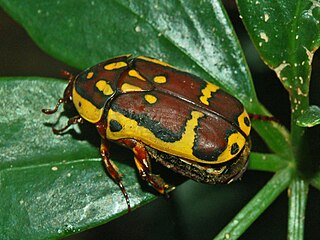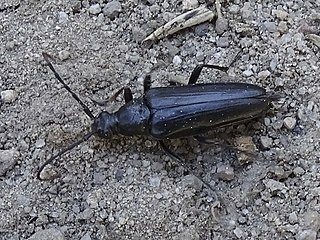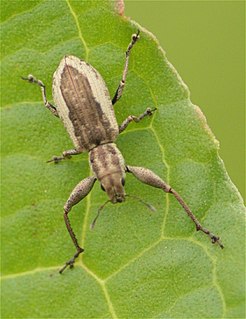
Parevander xanthomelas is a species of beetle in the family Cerambycidae. It was described by Félix Édouard Guérin-Méneville in 1844, and has been classified in the genus Parevander since the circumscription of that genus by Per Olof Christopher Aurivillius in 1912.

Pachnoda fissipunctum is an African scarab beetle in the subfamily Cetoniinae. It was originally described in 1885 as a variety of Pachnoda flavicollis.

Geonemini is a weevil tribe in the subfamily Entiminae.
Plectromerus exis is a species of beetle in the family Cerambycidae. It was described by Zayas in 1975.

Callimoxys is a genus of long-horned beetles in the family Cerambycidae. There are about eight described species in Callimoxys.

Etorofus anthracinus is a species of beetle in the family Cerambycidae. It was first described by John Lawrence LeConte in 1875. They are found in North America and can be observed seeking the dead parts of living trees for development.

Aristobia approximator is a species of beetle in the Longhorn family. This species grows to 36mm.
Agabus africanus is a species of predatory diving beetle belonging to the family Dytiscidae. It is endemic to Tunisia, where it is found in the area of the Cap Bon peninsula. It is not common.
Baliosus californicus is a species of tortoise beetle or hispine in the family Chrysomelidae. It is found in Central America and North America. The Baliosus Californicus is a leaf-mining, chrysomelid beetle with adult like eating habits.

Pandeleteius is a genus of broad-nosed weevils in the family Curculionidae. There are over 150 described species in Pandeleteius, distributed across the Americas. Most species in the genus were described by Anne Howden.

Trichoferus campestris, the velvet longhorned beetle, is a species of long-horned beetle in the family Cerambycidae. It is native to the southeastern palearctic, from Japan through to Armenia and southeastern European Russia, and is an invasive species in North America. The velvet longhorned beetle has begun to expand its range within Europe as well, spreading west.
Silusida is a genus of rove beetles in the family Staphylinidae. There is one described species in Silusida, S. marginella.
Bryelmis rivularis is a species of riffle beetle in the family Elmidae. It is found in North America.
Bryelmis is a genus of riffle beetles in the family Elmidae. There are at least three described species in Bryelmis.
Bryelmis idahoensis is a species of riffle beetle in the family Elmidae. It is found in North America.
Bryelmis siskiyou is a species of riffle beetle in the family Elmidae. It is found in North America.
Graphops is a genus of leaf beetles in the subfamily Eumolpinae. There are 19 described species in Graphops, all from North America. Most species have limited flight capabilities, due to poorly developed wings, and at least one species is known to be flightless.

Cnestus mutilatus, commonly known as the camphor shot borer, camphor shoot borer, or sweetgum ambrosia beetle, is a species of ambrosia beetle in the subfamily Scolytinae of the weevil family Curculionidae. It is native to Asia, but has been established as an invasive species in the United States since 1999.
Hydrophilus ensifer is a species of water scavenger beetle in the family Hydrophilidae found in the Americas. As of 2020, there are two valid subspecies of H. ensifer, H. e. ensifer and H. e. duvali, however the differences among the subspecies are not well understood.

Telegeusinae is a small subfamily of beetles in the family Omethidae recognizable by enlarged palpi found in males. Though relatively rare, males are sometimes found in large numbers in black light traps. Females are not known in this group, but it is theorized that females are larviform as found in many closely related taxa.










